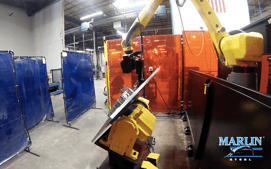Robotic welding is a great advancement that manufacturers can use to meet the demands of the welding process. Many American manufacturing companies make use of robotic welding systems to produce more efficient work in a timely manner to ensure they stay competitive in the market.

Every welding technique, whether it is manual or robotic, has its own set of pros and cons.
Learn some key facets of robotic welding and get a list of some of the pros and cons to decide if robotic welding will work for your needs.
What Is Robotic Welding?
Robotic welding, also known as automated welding, refers to the process of fusing two materials together using mechanized programmable tools that heat, mix, and cool metal materials.
Marlin invests in factory automation by using robotic MIG and TIG welding machines to make their manufacturing faster and more consistent.
Robotic Vs. Manual Welding: What's the Difference?
The main difference between robotic and manual welding is that manual welding is performed by humans, rather than machines.
Here are some other key differences between robotic and manual welding:
- It's easier to tell if there is a malfunction with manual welding. People will notice if there is a malfunction, but robots keep working.
- Manual welding is more hazardous to humans and involves more risk than robotic welding.
- Robotic welding is often a highly reliable process with quality results, but it can be inflexible unlike manual welding.
- Manual welding is more flexible because humans are more adaptable than robots and are able to handle different weld types.
Benefits of Robotic Welding
Here are some of the benefits of robotic welding for manufacturing.
Weld Quality
Automated processes and controllers ensure that weld integrity is refined with consistent results for fast quality welds.
There is also no issue with human error, fatigue, or distraction that may cause defects, unlike manual welding.
Reduced Waste
When welds are performed incorrectly, it leads to scrap metal and other wastes. Due to more accurate and precise welding, there is less scrap metal and waste with robotic welding.
Decreased Production Cost
Automated welding machines perform various welding processes day and night with less manpower than manual welding. This means you don't need to hire additional staffing for production.
Additionally, you won't have to consider labor costs such as injury, sick leave, staff turnover, or overtime.
Higher Output
Robotic welding doesn't rely on the endurance of human staff to produce the work. Automated processes speed up output by working longer and moving faster than manual welders can.
Cons of Robotic Welding
Here are three cons of robotic welding for you to consider.
Initial Cost
Although you save money on production costs with robotic welding, the upfront costs for the automated machinery is often quite expensive.
Not only is the initial cost expensive, but you must factor in the amount it costs for the machinery to be maintained.
Technical Issues
As with any technology, you may face technical issues with automated welding machinery. Companies that are fully reliant on robotic welding could shut down for hours or days if the welding machinery breaks down.
Lack of Flexibility
Robotic welding machines can carry out the same tasks routinely.
But if you require the machines to weld a different way or to carry out other processes, the machines must be reconfigured. This usually takes extra time and money to do.
Using the Right Welding Techniques for Your Needs
Marlin uses only the best Lincoln automated welders to fabricate materials for a variety of applications that fit your needs. They use two different types of arc welding processes called metal inert gas (MIG) welding and tungsten inert gas (TIG) welding.
The Lincoln welding system that Marlin uses has perceptive laser touch sensing to set coordinates and track a welding piece to ensure high quality welds. It also has a tilting and rotating positioning table that makes welding safer, faster, and more consistent.
Contact Marlin Steel today to find out which welding techniques their degreed engineers will use on your custom steel applications.



.gif)


